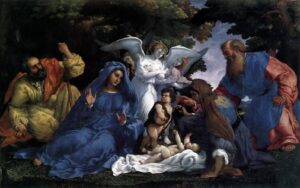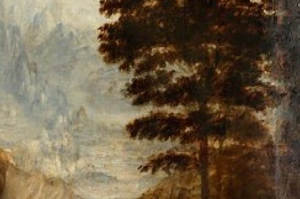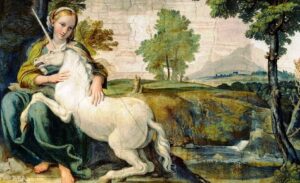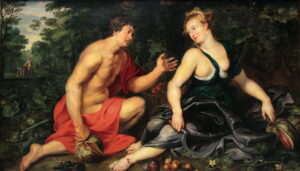The first public notice relative to Michelangelo Merisi is the registration of his baptism, a sacrament administered to the child in the church of Santo Stefano al Brolo, in Milan. The ceremony took place on 30 September 1571, in the presence of his father, his mother and his godfather, Francesco Sessa.
vent. Serving as witnesses were Marchese Francesco Sforza and a member of the noble Secco d’Aragona family. Michelangelo would be born eight months later.
Lucia Aratori, Caravaggio’s mother, was the daughter of the town surveyor, Gian Giacomo, a well-educated man, public administrator and fiduciary of the Sforza marchesi. Lucia belonged to a higher social class than that of her husband. Her family, which boasted a coat of arms with a dragon rampant on a starry blue background, belonged to the urban professional patrician class. A great-uncle of Michelangelo’s maternal grandfather was a notary by profession. He owned a gothic building next to the old municipal headquarters, which he had decorated with painted ceilings and small panels on which were painted portraits of himself and his wife, the family coat of arms and illustrious historical and mythological figures. The palazzo was then inherited by Michelangelo Merisi’s great-grandfather and later ceded to the marchesi, who merged it with the town hall to form their feudal residence.
When still very young, Michelangelo was sent to the countryside to stay with his maternal grandparents in the house at Porta Folcero, while his parents remained in Milan with his little brother, Gian Battista, and half-sister. In 1576 his name does not appear along with those of his relatives living in Milan. His early education was entrusted to his grandfather, Gian Giacomo, who might have taught the young boy basic drawing techniques, accompanied him on visits to the sites of the sanctuary and showed him the works of local artists who had met with success as painters, such as Fermo Stella, Prata da Caravaggio and il Moietta, taking care to mention the work of Polidoro da Caravaggio, who had enjoyed great success in Rome.
Between 1583 and 1584, Caravaggio’s mother, Lucia, in consultation with her father, Gian Giacomo, chose artistic training for the thirteen year old Michelangelo Merisi. She did not opt – as was often done – for a simple apprenticeship, instead placing her son as a student, which required the payment of rather high fees. A four-year period of training, to last until 1588, was decided on.
Caravaggio’s life in Milan played out in contiguous neighbourhoods. The residence-workshop of Merisi’s maestro, Simone Peterzano, was in the parish of San Giorgio al Pozzo Bianco. Michelangelo lived and worked there from fourteen to eighteen years of age. The recent identification of more mature drawings by the young apprentice permit the claim that the temporal terms of the contract were respected and that Caravaggio did not withdraw from his obligation prior to the agreed date.
Michelangelo Merisi found himself in the capital of the duchy in a position of privilege, surrounded by support and watchful eyes. In addition to his master – for whom he constituted a precious source of economic income – Caravaggio could count on a significant support network. His father’s brother, the priest Ludovico Merisi, lived in Milan, as did some wealthy relatives who dealt in furs. In the same year in which Caravaggio began his training, Costanza Sforza Colonna also arrived in Milan, and was to become a cardinal figure in his life.
The discovery of a drawing from the Peterzano school related to a scene from the Sacro Monte in Varallo allows the establishment, for the first time, of a very close connection between the workshop where Caravaggio studied and the “Mountain Theatre” so beloved by San Carlo Borromeo. The Sacro Monte, as we know well, is a natural setting meant to recall the Holy Land and other sacred locations – like places from the life of Saint Francis – and where small buildings scattered on a large hill are peopled with life-size statues set up in tableaux to recount the main episodes from the life of Christ and the saints. It should not be forgotten that Fermo Stella, the artist from Caravaggio, painted some frescoes at the Sacro Monte in Varallo and that visits to the site were encouraged by Carlo Borromeo and formed part of the devotional practice of good Christians. To which one would add that Carlo Bascapé, the spiritual guide of Costanza Colonna Sforza, became the director of the site. It is therefore highly plausible that Michelangelo Merisi had visited Varallo, bringing back with him indelible impressions.
Leaving the house-workshop of his master, Caravaggio took up residence in the neighbourhood of San Vito al Pasquirolo.
Simone Peterzano was called to the parish church in 1589-1590, to paint the altarpiece pictured at right. This work does not bear any trace of intervention by Caravaggio himself and this would seem to demonstrate the distancing – however temporary, as we shall see – of Merisi from Peterzano.
For many years, Carlo Bascapè was the spiritual guide of Costanza Sforza Colonna, the marchesa of Caravaggio and great protectress of the painter. This woman, who was also one of the main benefactors of the Congregation of the Barnabites, is portrayed, as we shall see, in the same painting, demonstrating that she was the donor of the intervention, which was clearly entrusted to the young man under her protection.
Costanza Sforza Colonna’s attention to the Merisi family and the interweaving of relations between the marchesa, the priest, the painter and his family are documented in two recommendations, in letter form, that Costanza and her daughter-in-law sent in 1600 to Bascapè, who had become the bishop of Novara, so that Giovan Battista Merisi, Caravaggio’s younger brother, would be ordained. The ordination took place in Novara – with a special procedure and an individualized ceremony – instead of in Cremona, the cleric’s diocese.
The relationship between the Colonna family and the Barnabites was very close. During the difficult early years of marriage, Costanza was watched over by Alessandro Sauli, and then by Carlo Bascapè. Letters indicate political and economic undertakings carried out by the marchesa in favour of the congregation. We can see her name listed among the main benefactors of the church of San Barnaba, where the painting is housed.
Click below to download the pdf of the discovery – Vol. I and II









